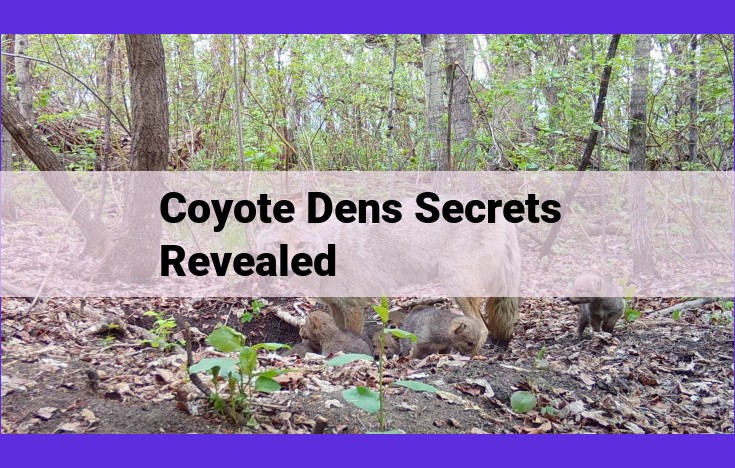Coyote dens are essential to the survival and adaptation of these enigmatic creatures. They provide shelter, protection, and a home base, as well as crucial support for reproduction and pup survival. Studying dens offers valuable ecological insights into coyote behavior and habitat utilization. Preservation of these vital habitats is paramount for ensuring the well-being and future of coyote populations.
Coyote Dens: The Vital Refuge for Survival and Adaptation
In the realm of wildlife, coyotes stand as resilient and adaptable creatures, their presence gracing various habitats across North America. Their success owes much to the significance of coyote dens, which serve as indispensable sanctuaries for these fascinating animals.
Safety and Shelter: A Fortress Against the Elements
Coyote dens are more than mere holes in the ground; they represent vital refuges. Within these subterranean havens, coyotes find protection from predators, the harshness of the elements, and other potential threats. Dens provide a sense of security, enabling coyotes to rest and retreat when danger looms.
Comfort and Recuperation: A Home Away from Home
Beyond protection, coyote dens offer comfort and seclusion. As temporary or permanent shelters, they provide a home base where coyotes can escape the hustle and bustle of the wilderness. Whether seeking refuge from a storm or simply enjoying a peaceful nap, dens fulfill the essential need for rest and rejuvenation.
Reproduction: Nurturing the Future
The reproductive process of coyotes is intricately intertwined with the availability of dens. These sheltered spaces provide a protected environment for raising pups, shielding them from the perils of the wild. Dens ensure the survival of the next generation, fostering the continuity of coyote populations.
Safety and Protection: Coyote Dens as Vital Refuges
In the wild, survival is a constant struggle, and coyotes have evolved a remarkable adaptation to enhance their chances: the coyote den. These inconspicuous dwellings serve as sanctuaries, safeguarding coyotes from a myriad of threats that lurk within their unforgiving surroundings.
Coyotes face a relentless pursuit from larger predators, such as wolves and mountain lions, who pose a constant danger. Dens provide a secure haven, shielding coyotes from these formidable adversaries. The intricate network of tunnels and chambers within the den makes it difficult for predators to navigate and locate their prey.
Protection from the elements is another vital function of coyote dens. During harsh weather conditions, such as torrential downpours or extreme heat, coyotes retreat to their dens for shelter. The dens offer a warm and dry sanctuary, protecting the animals from hypothermia, dehydration, and other weather-related ailments.
Beyond these immediate threats, coyote dens also shield the inhabitants from potential dangers such as human encroachment and disturbance. In areas where human activity is prevalent, dens provide coyotes with a secluded retreat, allowing them to avoid confrontations and ensure their safety.
Furthermore, coyote dens offer a sense of security and peace of mind. Coyotes are territorial animals, and their dens provide a familiar and protected space where they can rest, raise their young, and feel at home.
Shelter and Comfort: The Oasis for Coyotes
In the vast wilderness, coyotes find solace and comfort within the confines of their dens. These intricate structures, either temporary or permanent, serve as their home base, a refuge from the harsh elements and a haven for rest and relaxation.
Secluded Sanctuaries
For coyotes, dens offer a sanctuary from the watchful eyes of predators. Tucked away in secluded nooks and crannies, these burrows provide a sense of security and privacy. They can be found beneath dense vegetation, amidst rock formations, or within the hollow trunks of fallen trees.
Cozy Abodes
Inside their dens, coyotes find warmth and dryness. The walls of the den insulate them from the cold winter air and the scorching summer sun. Dried leaves, soft grasses, and other materials line the floors, creating a comfortable and inviting atmosphere.
Rest and Relaxation
Dens provide a tranquil space for coyotes to catch some shut-eye, away from the hustle and bustle of the outside world. These subterranean retreats offer respite from the pressures of hunting, foraging, and raising young. In the depths of their dens, coyotes can recharge their batteries and emerge rejuvenated.
Raising the Next Generation
Dens play a particularly critical role in the lives of coyote pups. During the breeding season, expectant mothers seek out dens with ample space and protection. After giving birth, they remain within the den for several weeks, nursing and nurturing their litter. The dens provide a safe and sheltered environment for the young coyotes to grow and develop, protected from the elements and potential threats.
Ecological Significance
Beyond their importance to individual coyotes, dens also have ecological significance. They are indicators of habitat quality and provide valuable insights into coyote behavior. Studying dens can help researchers understand how coyotes utilize their environment, interact with other species, and cope with human-induced changes. The preservation of coyote dens is crucial for maintaining healthy coyote populations and ensuring the ecological balance of their habitats.
Den Construction and Ownership: Resourcefulness and Territoriality
In the world of coyotes, dens play a pivotal role in their survival and adaptation. These remarkable creatures exhibit a remarkable level of ingenuity and resourcefulness when it comes to constructing and owning their dens.
Coyotes are skilled diggers, often excavating their own dens in embankments, slopes, or under dense vegetation. They utilize their sharp claws and powerful teeth to create elaborate burrows with multiple chambers and entrances. These dens provide essential protection from predators, extreme weather, and potential threats.
In some cases, coyotes may adapt abandoned dens created by other animals, such as foxes or badgers. They display a remarkable flexibility in recognizing and utilizing existing structures that meet their specific requirements.
Furthermore, coyotes exhibit a strong sense of territoriality when it comes to their dens. They actively defend their territory from intruders, including other coyotes, to ensure their exclusive access to this vital refuge. This ownership concept plays a crucial role in maintaining social dynamics within coyote packs and preventing conflicts between rival groups.
Reproduction and Survival: Nurturing the Future
For coyotes, dens are not merely temporary shelters but also indispensable sanctuaries for nurturing their future generations. During the breeding season, female coyotes seek out secluded, well-protected dens to give birth to their litters. These dens provide a haven for the helpless pups, shielding them from predators, harsh weather, and other potential threats.
A Protected Environment for Pups
Within the cozy confines of the den, newborn coyote pups are safe and secure. The den’s well-camouflaged entrance makes it difficult for predators to detect, while the surrounding vegetation provides additional protection. The pups remain hidden within the den until they are old enough to fend for themselves, protected from the watchful eyes of coyotes, wolves, and other potential predators.
Ensuring Survival and Growth
The stable temperature and humidity within the den create an optimal environment for the pups’ development. The soft bedding and ample space allow them to rest comfortably and grow without hindrance. The den’s proximity to food and water sources ensures that the pups have access to the nourishment they need to thrive.
A Nurturing Space for the Family
Dens are not just protective shelters but also vibrant spaces where coyote families bond and nurture their offspring. The presence of the mother coyote provides constant care and protection, while the pups interact with each other, playing and learning essential survival skills. The den becomes a focal point for the coyote family, a place where they can rest, raise their young, and forge lasting bonds.
Preserving Dens for Future Generations
The importance of coyote dens cannot be overstated. They are essential for the survival and reproduction of these fascinating creatures. Preserving these vital habitats is crucial for maintaining healthy coyote populations and ensuring the balance of ecosystems. By understanding the significance of coyote dens, we can all contribute to their protection and ensure that future generations of coyotes have a safe and nurturing place to call home.
Ecological Insights: Uncovering Behavioral Patterns in Coyote Dens
Amidst the rugged landscapes they inhabit, coyotes rely heavily on their dens not only for shelter and reproduction but also as a window into their fascinating behavioral patterns. Studying these dens has yielded valuable ecological insights that shed light on their social dynamics, habitat utilization, and the crucial role they play in conservation efforts.
Social Dynamics:
Coyote dens serve as social hubs, where members of a pack gather to interact and establish hierarchies. By observing den usage patterns, researchers have gained a deeper understanding of the social structure of coyote packs, including the formation of pack bonds, dominance relationships, and the roles of different individuals within the group.
Habitat Utilization:
The location and characteristics of coyote dens provide valuable information about their habitat preferences. Dens are often situated in areas with optimal cover and access to resources, such as water, food, and denning sites. Studying den placement can help identify critical habitats for coyotes and guide conservation strategies aimed at protecting these areas.
Conservation Efforts:
Understanding where and how coyotes use their dens is essential for effective conservation management. Denning sites are often targeted by human activities such as development or persecution, which can disrupt coyote populations and disrupt their ecological balance. By identifying and preserving denning habitat, wildlife managers can safeguard coyote populations and ensure their long-term survival.
Coyote dens are not just physical structures but vital components of their ecological landscape. Studying these dens has provided invaluable insights into coyote behavior, habitat preferences, and the conservation challenges they face. By understanding and protecting these vital refuges, we can ensure the well-being of coyotes and maintain the delicate balance of our natural ecosystems.




